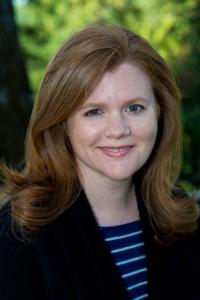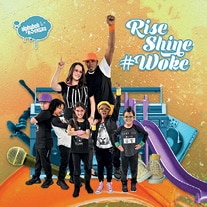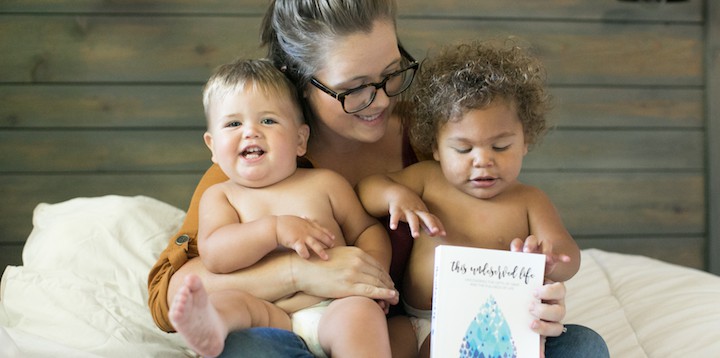 Take Five: Amy Beacom
Take Five: Amy Beacom
Amy Beacom, an inner-Southeast mom of two, knows the difficulties working parents face, particularly when they welcome a new child to the family. She founded the Center for Parental Leave Leadership (CPLL), a company that coaches other businesses on how to shape their policies to support working parents. Additionally, CPLL spends a quarter of its time advocating for paid leave for all.
Q: What drove you to found the Center for Parental Leave Leadership?
A: It was really a reaction to what I experienced after having my son nearly 11 years ago. I became a mother and what I now call the “transition from working person to working parent” sucker punched me. Completely. So I shifted my career from leadership development and executive coaching to creating a new field of parental leave consulting and coaching. From my personal trial came the insight that all of us in this country — parents, companies, politicians — were getting parental leave wrong. Which meant there was a big opportunity for companies who could get it right.
Q: Can you name some of the companies CPLL has worked with?
A: Usually our clients are enterprise level companies, like Microsoft, Danone or Phillips 66, but our favorite client this year has been Portland-based PAE Engineers — the first engineering company in the country to offer paid leave.
Q: Are you seeing a shift in more companies being open to paid parental leave?
A: Absolutely. Hardly a week goes by without a big announcement about a generous new paid leave policy. There’s a talent war going on and millennials, who are now the largest generation in the workforce, really value a family-friendly workplace. We’ve seen a good number of small- to medium-sized Oregon businesses finding a way to offer some form of paid parental leave, and being very glad they did.
Q: Many small businesses say they can’t afford to offer paid parental leave. What would you say to a small business owner about the cost?
A: Small businesses are like families, so employees expect to be treated with care. Also there’s a cost to doing nothing. You’re potentially losing out on recruitment and you’re definitely losing out on retention. We’ve worked with small businesses who were surprised that when they actually crunched the numbers, paid leave was a no-brainer.
What I do, and I suggest other small business owners do, is get involved in the effort for paid leave legislation. Right now advocacy groups are working towards a paid leave bill that will hopefully be adopted by Oregon in early 2018. It would create an insurance program based on a paid leave model that’s working well in four other states. Like car insurance, it spreads the cost across employees and employers in a statewide pool so it becomes virtually painless.
Q: What should companies be doing to support parents when they come back from leave?
A: Manager training is key. Managers need to understand both why and how to support new employees. There are two easy (and free!) things any manager can do: Ask the new parent what type of flexibility and support would be most helpful and trust that the new parent will do their best for you. Employees who feel trusted rarely let their employers down and have profound loyalty to the manager and company who supported them during complex times. — Denise Castañon


Playlist: Social Justice Soundtrack
The Alphabet Rockers want to change the world. Sounds like a tall order, but with the release of their new album Rise Shine #Woke, with its strong hip-hop beats and compelling, uplifting lyrics, they’ve got this. With snippets of President Obama speaking “We are the change that we seek” woven into the music, the song Rise is especially powerful. (And Michelle Obama’s famous quote “When they go low, we go high” becomes a lyric.) While each track from duo Kaitlin McGaw and Tommy Shepherd does an exceptional job of raising awareness as it serves up world-class hip-hop, the multi-lingual rap Walls is especially poignant. And with the lyrics, “I don’t look like you, but I still got your back,” the song Stand Up for You emerges as an unwavering kid ally anthem. Peppered between tracks are interludes of kids talking and rapping about friendship and acceptance. Want your kid to be the change? This is the album they need to hear right now. — D.C.
TOP 5 …Hot Chocolates for Chilly Days
➊ Cacao Drink Chocolate, SW Portland: The holy grail for hot chocolate lovers. Rich, creamy, decadent perfection. The kids won’t share, so best to order your own.
➋ Pip’s Original Donuts, NE Portland: Try it spiked with chai, and paired with a Nutella-drizzled doughnut.
➌ Oui Presse, SE Portland: Not-too-sweet, extra foamy, and in a good spot for people watching.
➍ Fleur Chocolatte, Vancouver, Wash: A second-generation chocolatier makes hot chocolate in the French style. Oui, oui, s’il vous plait!
➎ Cup and Bar, NE Portland: Small-batch, handmade Ranger chocolate as the source = an artisanal cup for you and the littles. — Julia Silverman
We Recommend
Five years ago, Oregon government officials made a bold promise: By the year 2025, every kid in Oregon would graduate from high school on time. Oregon Public Broadcasting reporter Rob Manning decided to fact-check them. For the past five years, he’s been following a group of kids that began as kindergarteners in the David Douglas School District, documenting their lives and those of their families. For its five-year anniversary, the series has moved into podcast form, with episodes that delve into how kids learn when they don’t have a home, and what happens when immigrant kids and their parents speak a different language. It’s insightful, can’t-miss reporting — add it to your podcast rotation via iTunes or find it at opb.org. — J.S.

Gear Guide: First Plates
The most important accessory for your baby’s first solid foods is, of course, your camera. (Just make sure none of that mashed up avocado or sweet potato gets flung at the lens.) But right after that is baby dinnerware — you want something sturdy, but Insta-friendly too. Here are our favorite picks for first bites.
NumNum’s Beginner Bowl gets points for its sloped walls that help guide a child’s utensil to the food. And their GOOtensil “pre-spoon” gets double points for its flat head design, which means there’s no wrong way for little hands to grasp it. $14 and $9. At The Bull and the Bee, 1540 SE Bybee Blvd.
The Avanchy Bamboo Baby Bowl is sleek enough for any mid-century modern fan. It comes with a silicone base that easily attaches to any flat surface, and a quick-release tab at the bottom for when dinner is over. They throw in a BPA-free silicone spoon, too. Hand-wash only. $19.99. At EcoBaby Gear, 7980 SE Stark St.
4-Moms Magnetic Magic, a super-smart, all-you’ll-need-for-awhile starter set comes with magnets that keep bowls and plates in place on the company’s tray. (So no spills, no matter how determined the little.) We love that this one is portable, so you can fill it up with snacks and put on the lids when you’re on the go. It’s dishwasher safe, too. $39.99. At Posh Baby, 916 NW 10th Ave. — J.S.


Follow This: The Journey to Mom
Portland writer/photographer Natalie Brenner was just 20 weeks pregnant when she met her son. No, this isn’t a story about a micro-preemie’s fight for survival. It was her other meant-to-be son, adopted at birth after a long and agonizing wait to be chosen by a birth parent, and a furious attempt to find the money to pay the adoption fees. Brenner writes movingly about her family’s “match day,” how it feels, nearly a year-and-a-half later, to be the mother to two boys who are just 4-and-a-half months apart in age, about the intricacies of transracial adoptions and how grief can be one of life’s greatest gifts. She’s collected these hard-won lessons in a new book, This Undeserved Life, as well as on her blog, at nataliebrennerwrites.com — a perfect read for National Adoption Awareness Month. (And for the sweetest pictures of her adorable sons, check out her Instagram at @nataliekbrenner.) — J.S.
Good Deeds
Salt & Straw is known for its slightly wacky flavor profiles, but their monthly specials this past June had a particular twist. All five flavors were made from food that otherwise would have been thrown away — just like the estimated (and shameful) 40 percent of food in the United States that goes to waste each day. The flavors were inspired by — and a portion of proceeds given to — Urban Gleaners, the Portland-based nonprofit whose mission to collect food that would otherwise go uneaten and deliver it to those in need. The nonprofit picks up food from multiple points in the metro area — organic, unsold produce from local farmers’ markets, leftover chicken, ribs and briskets after a Trail Blazers game, and dairy and eggs that have just hit their sell-by dates from local supermarkets. All that bounty gets distributed to 40 plus sites in Portland, including 24 school-based pantries. They even run “mobile markets” that park in neighborhoods that are underserved by grocery stores, for residents to browse at their leisure. If you’ve got wheels and an extra few hours per week, they are looking for folks who can make pickups of surplus food and deliver it to organizations that feed the hungry. Pack up the kids, pop in some tunes, and go help out. More info at urbangleaners.org. — J.S.
Bookshelf: Rush the Stage
The West Coast’s best book festival is back! Wordstock hits Portland this month and to celebrate, we asked our kid-lit experts, Kim Tano and Richard Corbett from Powell’s Books, to pick their favorites from among those who will be appearing at the one-day author-palooza.
Catch all the literati at the festival on Saturday, November 11, 9 am-6 pm at the Portland Art Museum. Tickets are $15 in advance and $18 at the door, but free to ages 17 and under, and include admission to the Portland Art Museum.
Radiant Child by Javaka Steptoe
This beautiful and moving biography of New York artist Jean-Michel
Basquiat won the Caldecott award for the best illustrated children’s book of the year. The colorful, collage-type paintings echo Basquiat’s own style and prove that art doesn’t need to stay inside the lines. $9.99.
Leave Me Alone! by Vera Brosgol
Local author Vera Brosgol presents this hilarious tale about a grandmother who just wants to get her knitting done. She travels to the forest, the mountains and space to be left alone to complete her sweaters. (And watch for Brosgol’s new graphic novel for middle-grade readers, Be Prepared,
coming next spring.) $17.99.
Super Narwhal and Jelly Jolt by Ben Clanton
Opposites attract, or so the saying goes, and that proves true in this second book about Super Narwhal and his trusty sidekick Jelly Jolt, by the Seattle-based Clanton. Narwhal is devil-may-care and Jelly Jolt is exceedingly practical and together they have plenty of under-the-sea adventures. $12.99.
Lemons by Melissa Savage
After her mother’s death, Lemonade Liberty Witt is sent to live with her grandma in a nondescript California town that has one claim to fame: It’s the Bigfoot Capitol of the world. Our heroine joins up with an 11-year-old detective to hunt for the mysterious beast, but she’ll wind up learning much more along the way. $11.95.
Getaway: Columbia River Gorge
The Eagle Creek fire this summer broke Portland’s collective heart, and left many of us wondering what we could do to help restore our beloved Columbia River Gorge. Here’s one answer: Go visit, and help out those who depend on tourist dollars. Base yourselves in the hip little burg of White Salmon, Wash., just across the Columbia from Hood River, where you’ve got easy access to some of the region’s best (and fire unaffected) trails. Our pick for late autumn is Falls Creek Falls in the Gifford Pinchot National Forest, 3.4 miles out and back with minimal elevation gain and some beautiful fall color, courtesy of the resident alders and maples.
For indoor fun, the Columbia Gorge Interpretive Center has neat exhibits on the history of the area, or you can buy a day pass to the indoor pool and hot tubs at Skamania Lodge. Get a jump on holiday shopping at the friendly G. Willikers’ toy store in Hood River, or buy books for everyone on your list at the independent Waucoma Books, just up the street. When it’s time to eat, we like Everybody’s Brewing in White Salmon — their kid’s menu has a pick-three, build-a-plate option for $7 and includes healthy choices like black beans, roasted sweet potatoes and red grapes; their beer selection can throw down with the best of PDX’s brewpubs. Bunk down at the historic old Inn of the White Salmon, where the family king suite comes with bunk beds and a comfy king-sized bed for you. — J.S.
Ask Dr. Corey
Q: We know we’re short on sunshine in Oregon, but we’ve also seen news recently that vitamin D supplements have been overhyped. How much do we really need, what can we get from food, and is a supplement necessary?
A: Many a Pacific Northwesterner has, I’m sure, spent days during our rainy winters pining for a ray or two of warm, vitamin D-laden, sunshine.
Though rickets (a disease where the bones don’t harden properly) is not a new problem, its link to low vitamin D levels wasn’t figured out until the 1920s. After that, major pushes were made to attempt to fortify foods with vitamin D to prevent rickets and its complications.
For a variety of reasons, vitamin D deficiency appears to be on the rise and has come back to the fore since several studies were published between 2004 and 2011 or so. These studies all looked at bone density in otherwise healthy people and/or amounts of vitamin D in the blood. A surprising amount of people thought to be otherwise healthy had either evidence of low vitamin D levels and even some early bone changes. The percentage of people affected was between 20 and 30 percent, or even more in some studies.
Thankfully, prevention of vitamin D deficiency and rickets is pretty simple. The American Academy of Pediatrics recommends a supplement of 400 IU of vitamin D for all babies under a year unless formula fed and consuming more than 32 ounces of formula in a 24 hour period. In order for sufficient quantities of vitamin D to pass from mother to infant through breast milk, a mother has to take about 6000 IU of vitamin D supplement daily. For children over 1 years old, the recommended daily intake is 600 IU.
Most of us probably picture those red “Vitamin D Milk” cartons when thinking about dietary sources of vitamin D. However, in addition to fortified foods, there are several natural sources of Vitamin D.
A single serving of wild salmon can contain up to 1000 IU of vitamin D and several wild mushroom species contain significant quantities of vitamin D. Egg yolks are another good source.
Given the amount of data surrounding vitamin D supplementation, I definitely recommend that families pay attention to diet, make sure that children are getting plenty of outdoor exercise, and consider a supplement if either diet or activity level are limited.
- Vote for Your 2025 PDX Parent Reader Favorites! - January 2, 2025
- Your Go-To List for Lunar New Year Family Fun - December 30, 2024
- Ring in the New Year with Family-Friendly Celebrations - December 30, 2024
